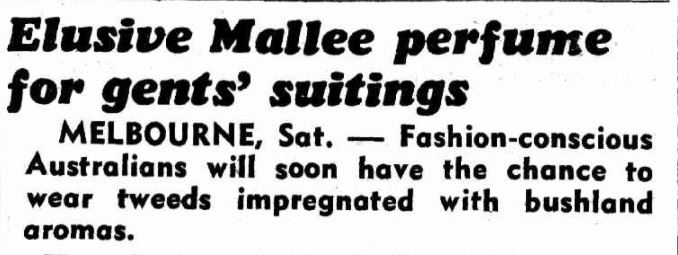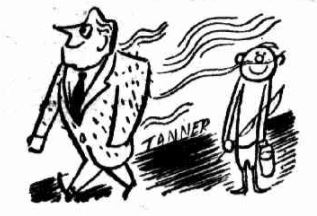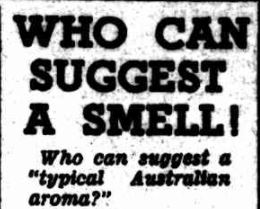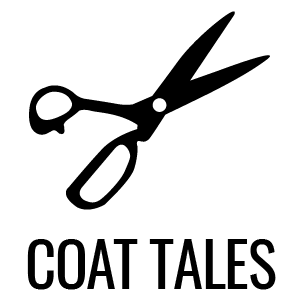We all know that we feel our clothes – when they’re too tight around the waist, when they itch our skin or when they ride up, demanding constant readjustment. But have you thought about how you smell your clothes? This might be the fresh scent of laundry powder or the reek of sweat, though cloth has also been infused with aroma as part of its manufacture.
In February 1950, Melbourne’s Argus newspaper reported on an astonishing range of new tweed fabrics that smelt of bushland aromas. One was called ‘Mallee’, presumably either after the north-western Victorian region of that name or the distinctive shrubland habitat.

Mallee tweed was coloured a ‘rich, earthy brown’. It had an ‘elusive polished saddle leather aroma’ that was not intended to be noticed by people on the street. Rather, the manufacturer Godfrey Hirst Mills in Geelong explained, a man would open his wardrobe and find it richly scented. He would be transported ‘to that mist-laden fern gully of [his] memories’, the mill suggested somewhat romantically (especially for men who lived in the dry Mallee region).

Inspiration for the cloth had been taken from the ‘now-forgotten peaty tang’ of the genuine Harris Tweed – woollen cloth that had been made in the cottages of weavers in the Outer Hebrides islands of Scotland and that was so popular that it was protected from imitation by the name ‘Harris Tweed’ and its Orb trade mark. As another Australian newspaper, Mackay’s Daily Mercury, reminded its readers, Harris Tweeds ‘characteristic odour’ was a result of being dried in lofts heated with peat fires.
The cloth, that would apparently retain its bushland aroma for as long as it was worn, had been two and a half years in development. In 1948, the Argus first published a story altering its readers to Hirst Mills intention to produce the tweed. The mill wanted to hear from people about what they considered the typical Australian aroma – something, the company suggested, that might evoke the bush’s scent of eucalyptus.

The new scented tweeds were displayed at the Australian Fashion Fair at Melbourne’s iconic Exhibition Building for the curious in 1950. Though many newspapers around the country enthusiastically reported on the scented tweed, its public reception received far less fanfare. Was the Australian-scented tweed incorporated into the wardrobes of Australians, or did it remain a novelty?
References
‘Aroma sought for Aust. Tweed’, Daily Telegraph (Sydney), 20 December 1948, 7.
‘Elusive Mallee perfume for gents’ suitings’, Daily Telegraph (Sydney), 19 February 1950, 7.
‘Bushland aroma for our tweeds’, Tailor and Men’s Wear, March 1950, 23.
‘Harris Tweed’, Daily Mercury (Mackay), 29 October 1952, 10.
‘Harris Tweed in vogue: Crafty imitations, reproducing the peaty odour’, Sydney Morning Herald, 7 June 1939, 8.
The Handwoven History of Harris Tweed: Google Arts & Culture: https://artsandculture.google.com/exhibit/the-handwoven-history-of-harris-tweed-british-fashion-council/-gICDRacUjdSJQ?hl=en
‘You can have aroma of Mallee’, Argus (Melbourne), 18 February 1950, 3.
‘Who can suggest a smell!, Argus (Melbourne), 18 December 1948, 7.
